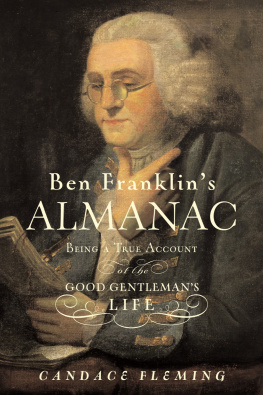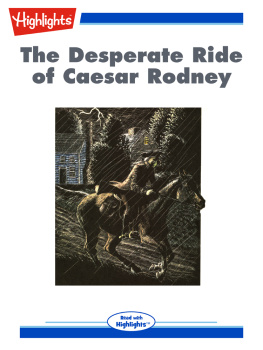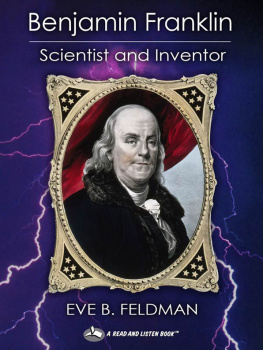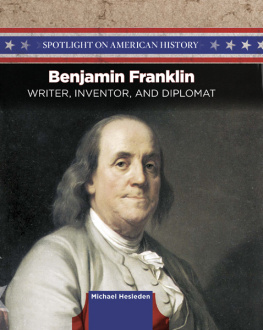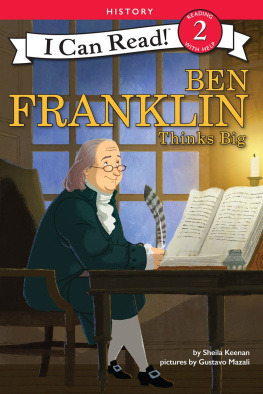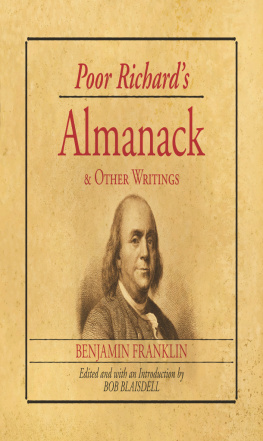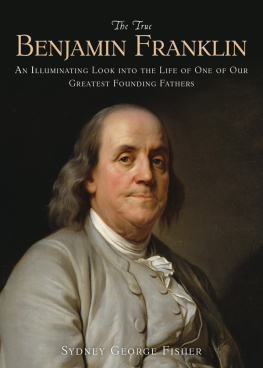ACKNOWLEDGMENTS
This book could not have been written without the help of many people. I am indebted to Roy Goodman, Valerie-Anne Lutz, and Robert Cox of the American Philosophical Society for patiently searching through numerous sources to find the very one I needed; Ellen Cohn and Natalie Lesueur of the Benjamin Franklin Collection at Yale University for searching out facts, tracking down photographs, and sharing that vast Franklin material; Sue Levy at the Cigna Museum and Art Collection for generously allowing use of the museums Franklin portraits; Holly Pribble and Eric Rohmann for contributing their considerable talents; Mrs. Jackson C. Boswell for graciously allowing her portrait of William Franklin to appear in these pages; and the superb and tireless staff at the Library of Congress who worked miracles obtaining obscure and out-of-print materials.
I would also like to thank Christopher Looby, professor of English at the University of California, Los Angeles, as well as Edward Martin, history teacher at the Berkeley Carroll School in Brooklyn, New York, for reading the manuscript with an eye for facts and a deep understanding of the subject.
And last, but not least, I am especially grateful to my editor, Anne Schwartz, whose advice and support have been constantly availableand invaluable.
ATHENEUM BOOKS FOR YOUNG READERS
AN IMPRINT OF SIMON & SCHUSTER
CHILDRENS PUBLISHING DIVISION
1230 Avenue of the Americas, New york, New york 10020
www.SimonandSchuster.com
Text copyright 2003 by Candace Fleming All rights reserved, including the right of reproduction in whole or in part in any form. Book design by Patti Ratchford The text for this book is set in Oneleigh.
Library of Congress Cataloging-in-Publication Data
Fleming, Candace.
Ben Franklins almanac: being a true account of the good gentlemans life / Candace Fleming.1st ed. p. cm.
An Anne Schwartz book.
Summary: Brings together eighteenth-century etchings, artifacts, and quotations to create the effect of a scrapbook of the life of Benjamin Franklin.
ISBN 0-689-83549-3
ISBN 978-1-4814-1799-0 (eBook)
I. Franklin, Benjamin, 17061790MiscellaneaJuvenile literature. 2. StatesmenUnited StatesBiographyMiscellaneaJuvenile literature. 3. PrintersUnited StatesBiographyMiscellaneaJuvenile literature. 4. InventorsUnited StatesBiographyMiscellaneaJuvenile literature. 5. ScientistsUnited StatesBiographyMiscellaneaJuvenile literature. [1. Franklin, Benjamin, 17061790. 2. Statesmen. 3. Inventors.] I. Title.
E302.6.F8 F55 2003
973.3092dc21
2002006136
A NOTE ABOUT THE TEXT: Because history is not an exact discipline, dates sometimes vary among source materials. In most cases when discrepancies occurred, the author used Carl Van Dorens account of events.
Most quotations have been excerpted from longer, original documents. Original spelling and punctuation have been modernized for readability and clarity.
CONTENTS
Courteous Reader:
B en Franklin once said, A mans story is not told solely by a list of his grand accomplishments, but rather by his smaller, daily goods. It is those smaller goods this book focuses on. Within its pages you will, of course, find mementos of his most famous achievements. After all, what book about Ben Franklin would be complete without mention of electricity, the American Revolution, or Poor Richards Almanack ? But you will also find scraps from some lesser-known events, as well as funny stories, hand-drawn sketches, cartoons of the day, and snippets of gossip. You will find souvenirs from Bens travels, keepsakes from his childhood, bits of his family life, and pieces of his private thoughts.
What you wont find is a chronological order to these bits and piecesthis is not your traditional biography. Of course, when I began the project, I meant to write one. But as I read Bens letters and essays, looked at pictures of his family, and uncovered Franklin stories and anecdotes, I began to see him differently. Innovative, vulgar, sometimes heroic, sometimes flawed, the incredibly complex Ben Franklin I discovered beguiled me, and I was no longer satisfied to tell his story in the ordinary way. I needed a form that would illuminate each of the many facets of his lifethe vastness of his interests and accomplishments, and the deep commitment he made to each one.
Ultimately, I hit upon the idea of gathering the bits and pieces by subject and putting them in chapters with titles such as Boyhood Memories, The Writers Journal, Revolutionary Memorabilia, et cetera. By organizing the book in this way, I hope you will clearly see each of the many, varied interests Ben pursued throughout his long life. You will watch specific events as they unfold, particular ideas develop, and relationships progress. You will also be able to open this book to any page and discover a piece of Benas in a scrapbook. And by using the time line at the beginning, you can, if you wish, place this piece within the whole context of his life.
And like a scrapbook, the story of Bens life has been centered around visualsportraits, etchings, cartoons, and sketches. These imagesmost created long agowill bring you face-to-face with history, and help you to connect with Ben the person, rather than just a name and dates. You will actually see Bens childhood home. You will see his electrical equipment, the faces of his family, the first pages of his most famous writings. And hopefully, like the individual pieces of a jigsaw puzzle, these snapshots will come together and a whole picture of Ben Franklin will emerge.
Luckily for us, so much of his life has been preserved. It seems that Ben himself kept all his papersevery letter, pamphlet, rough draft, article, drawing, visiting card, invitationeverything! He cherished these papers, and with his strong sense of history, understood that one day they would be useful. When he died, he left them to his grandson William Temple Franklin.
Unfortunately, Temple did not cherish them. Dividing the collection, he left half the papers with a friend, who stored them in his barn. There they remained for the next thirty years, gathering dust, growing mildew, and being given away as gifts to various houseguests.
The other half of Bens papers fared no better. Temple carried them to England, where he eventually abandoned them. Around 1840 they were discovered in a London tailor shop (Temple had once lived upstairs). Incredibly, the tailor had used them as patterns for the garments he was cutting.
All might have been lost if not for the efforts of institutions like the American Philosophical Society, Yale University, and the Library of Congress. Working independently of one another, these institutions rescued Bens papers from barn and tailor shop. They searched out other mementos of Bens life. They gathered, and are still gathering, many of the pieces together. They preserved them, published them, and cherished them as Ben would have. They also generously photographed them and made them available for the pages of this book.
Together these bits and pieces shape the story of Bens life and show us his many sideshis intense commitment, his wise reasonableness, his sense of social justice, and his unfailing good humor. Indeed, they show us both his grand accomplishments and his smaller goods.
Candace Fleming
A YEAR-BY-YEAR LOOK AT BENS LIFE
1706: Ben is born on Milk Street in Boston to Josiah and Abiah Franklin.
1712: Moves with his family to bigger house on Hanover Street
1714: Enters Boston Grammar (Latin) School
1715: Josiah decides he cannot afford the school and withdraws Ben. Enters Ben in Mr. Brownells school.
1716: Josiah withdraws Ben from Mr. Brownells school and puts him to work in his soap- and candlemaking shop.

